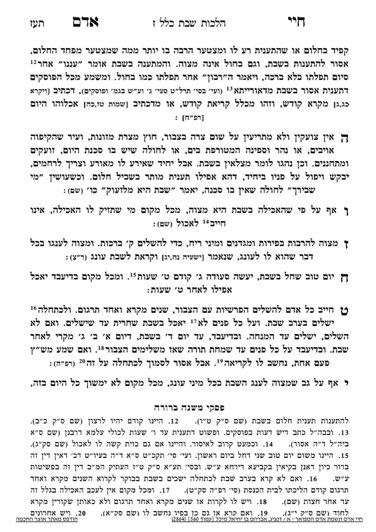The current series, which will cover seudos Shabbos and fasting on Shabbos, is available for sponsorship. Please contact Rabbi Reingold for more information.
We are continuing in siman 9, where the Chayei Adam discusses being maavir sedra. We will continue to clarify a few points not discussed by the Chayei Adam.
The Mishnah Berurah here points out that the parsha needs to be read in order. The Mishnah Berurah writes that if a person accidentally read out of order, they should ideally go back and read the parsha in order. The Kaf Hachayim writes that even bedieved, if a person goes out of order by accident, they must go back. However, the Ketzos Hashulchan disagrees and holds that bedieved a person is yotzei if they read out of order.
In siman 285:sk6, the Mishnah Berurah writes that it is a good thing not to interrupt at all from the beginning of the parsha until the end. The Shaar Hatziyun clarifies that the Mishnah Berurah is referring to interruptions between paragraphs, and is saying that it is a good thing not to interrupt even between those paragraphs. Interrupting within the paragraph itself is certainly assur. The Shaar Hatziyun explains that know that if a person stops learning for the purposes of conversation, they will be fed gachalei resamim, hot coals, for interrupting their learning. Interrupting within a paragraph is akin to interrupting one’s learning, so it is certainly assur to interrupt when in the middle of a paragraph. Similarly, the Be’er Heitev writes it is assur to interrupt during shnayim mikra.
Nevertheless, if a person has a valid reason to interrupt, it is not more stringent than any other time a person is learning where one should not interrupt their learning, but may do so for a valid purpose. Along these lines, drinking water while reciting the pesukim in order to have a clear voice, etc., is muttar.
Regarding the trop, the Mishnah Berurah points out (sk 17) that the trop is not meakeiv. Nevertheless, if a person is able to read trop, it is even better, and the Mishnah Berurah (sk 2) even suggests possibly using a sefer torah for shnayim mikra. Practically, the minhag is not to use a sefer torah, unless one is well known as a tzaddik. Regardless, the trop gives us an indication of the proper way to break up the pasuk, so it is appropriate to minimally use the trop as a way to correctly parse the pasuk.
There is no chiyuv shnayim mikra for extra parshiyos, such as the daled parshiyos or Yom Tov. The chiyuv shnayim mikra is only for the primary kriyas hatorah.
The order of Shnayim Mikra is mikra before targum (i.e., mikra-mikra-targum), because the pesukim are more chashuv than targum. However, the Chazon Ish would do mikra-targum-mikra. Since the entire purpose of shnayim mikra is to gain a greater understanding of the pesukim, he held it was more appropriate to learn the targum before the second mikra, so that he had a greater understanding of the mikra the second time. One has what to rely upon regardless of the order they use.
Summary
- The parsha should be read in order, but if a person accidentally read it out of order, bedieved they are yotzei.
- It is assur to interrupt while in the middle of a paragraph, just like one should not interrupt while they are in the middle of learning. It is muttar to interrupt for valid needs, just like it is muttar to interrupt learning for valid needs.
- Between paragraphs, it is preferable not to interrupt but it is not assur.
- It is preferable to read shnayim mikra with trop
- Shnayim mikra only applies to the regular kriyas hatorah, not to extra parshiyos.
- One can read shnayim mikra as mikra-mikra-targum or mikra-targum-mikra.



